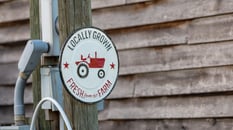For almost 20 years now in the United States grocery store consumers have been able to identify which country many of the commodities in their shopping cart come from thanks to a "cool" idea – specifically the Country of Origin Label (COOL) legislation.
The labeling law requires certain retailers, mostly grocery stores and supermarkets, to identify the country of origin of certain foods such as perishable agricultural commodities (fresh and frozen fruits and vegetables), peanuts, pecans, ginseng, macadamia nuts, wild and farm-raised fish and shellfish, and muscle cuts and ground chicken, goat, and lamb.
According to the Produce Marketing Association: “COOL is not a food safety program. It is a consumer labeling and marketing law regulated by the USDA's Agricultural Marketing Service. Restaurants and foodservice establishments, including foodservice operations within a supermarket, are excluded from the country of origin labeling law.”
History of COOL Legislation
The Country of Origin Labeling (COOL) legislation traces its roots back Agricultural Marketing Act of 1946, but its modern incarnation began when the 2002 Farm Bill amended that 1946 ag act to require retailers to notify customers of the country of origin of certain products.
The current COOL legislation was redefined by amendments in the 2008 Farm Bill and the 2016
The definition of which retailers are subject to COOL dates back before the Agricultural Marketing Act, to the Perishable Agricultural Commodities Act of 1930 (PACA).
Which Retailers Must Comply with COOL
COOL legislation applies to retailers subject to licensing requirements of PACA. Specifically, any person engaged in the business of selling any perishable agricultural commodity at retail must purchase a PACA license if they purchase more than $230,000 of fresh or frozen produce in a calendar year.
Restaurants and other food service establishments such as cafeterias, lunchrooms, etc. are exempt from COOL. Retailers that do not sell fruits and vegetables (e.g., fish markets and butcher shops) are not required to provide COOL information.
No Standardized COOL Format
COOL comes in many different formats because the legislation does not stipulate the exact size or placement of COOL declarations, only that the statements be “legible and placed in a conspicuous location where they are likely to be read and understood by a customer.”
Options for presenting COOL information include statements placed on a:
- Placard
- Sign
- Label
- Sticker
- Band
- Twist Tie
- Pin Tag
In addition to country of origin, fish and shellfish commodities must also be labeled at retail with the method of production which can either be farm-raised, farmed, wild caught or wild. In the case of muscle cuts of meat, suppliers must include the production step information (born/hatched, raised, and harvested).
The Agricultural Marketing Service encourages retailers and suppliers to place COOL information on the front of packaging used for fresh meat, fish and shellfish, and cut fresh fruit and vegetable products, also known as the principal display panel, so it will be readily apparent to consumers.
Region, State and Local COOL Designations
 Sometimes in the grocery store you might see “California Grown” or “Florida Fresh” on the label. Such designations must be nationally distinct. For example, Hill Country would not be an acceptable designation because the consumer would not know whether that was referring to a particular state or country. instead of “Grown in the USA”. This is okay because the 2008 Farm Bill allowed domestic and imported perishable agricultural commodities, macadamia nuts, peanuts, pecans, and ginseng to use state, regional, or locality label designations in lieu of the country of origin.
Sometimes in the grocery store you might see “California Grown” or “Florida Fresh” on the label. Such designations must be nationally distinct. For example, Hill Country would not be an acceptable designation because the consumer would not know whether that was referring to a particular state or country. instead of “Grown in the USA”. This is okay because the 2008 Farm Bill allowed domestic and imported perishable agricultural commodities, macadamia nuts, peanuts, pecans, and ginseng to use state, regional, or locality label designations in lieu of the country of origin.
Also, the term “Locally Grown” does not define a specific region and is not permitted as a COOL declaration.
Where’s the Beef (From?)
Consumers might be asking where’s the beef … from? And for that matter pork? According to the U.S. Department of Agriculture: “In December 2015, Congress rescinded beef, pork, ground beef and ground pork from mandatory COOL requirements.”
Thus, beef and pork, like dairy products, cereals, and grains, are not covered by COOL legislations.
Food Supply Chain Responsibility
Any person engaged in the business of supplying a covered commodity to a retailer, whether directly or indirectly, must make available information to the buyer about the country of origin and method of production (for fish and shellfish) or production step information (for muscle cuts of meat).
This information may be provided by one of three ways:
- On product itself
- On the master shipping container
- In a document such as an invoice, bill of lading or shipping manifest.
Retailers and suppliers are required to retain records that verify country of origin and method of production for one year from the date of transaction. The records can include any document used in the normal course of business and may be stored in any form (digitally or hardcopy) and in any location.
Contact FreshByte Software today to find out how our state-of-the-art traceability, backwards and forwards, can help keep your business in compliance with all government regulations including COOL.





